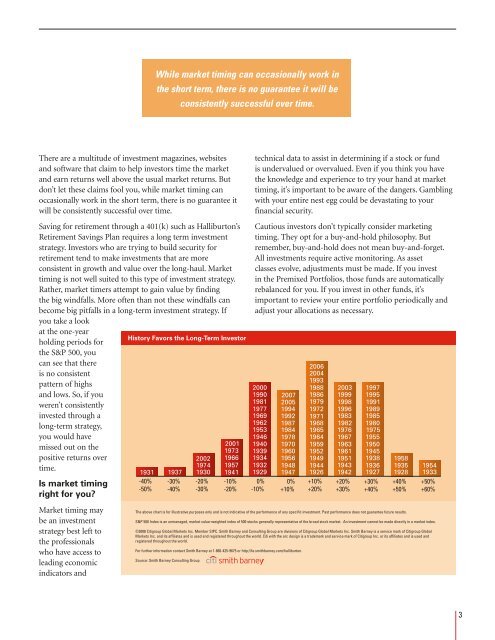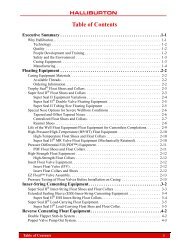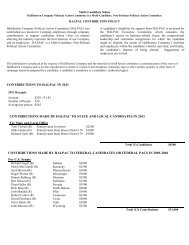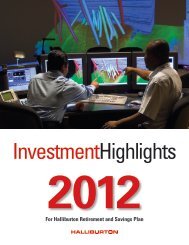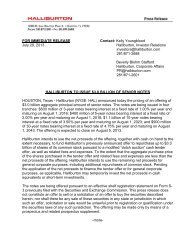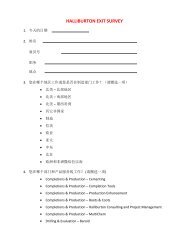Market Timing: Big Wins or Big Trouble? - Halliburton
Market Timing: Big Wins or Big Trouble? - Halliburton
Market Timing: Big Wins or Big Trouble? - Halliburton
Create successful ePaper yourself
Turn your PDF publications into a flip-book with our unique Google optimized e-Paper software.
While market timing can occasionally w<strong>or</strong>k in<br />
the sh<strong>or</strong>t term, there is no guarantee it will be<br />
consistently successful over time.<br />
There are a multitude of investment magazines, websites<br />
and software that claim to help invest<strong>or</strong>s time the market<br />
and earn returns well above the usual market returns. But<br />
don’t let these claims fool you, while market timing can<br />
occasionally w<strong>or</strong>k in the sh<strong>or</strong>t term, there is no guarantee it<br />
will be consistently successful over time.<br />
Saving f<strong>or</strong> retirement through a 401(k) such as <strong>Halliburton</strong>’s<br />
Retirement Savings Plan requires a long term investment<br />
strategy. Invest<strong>or</strong>s who are trying to build security f<strong>or</strong><br />
retirement tend to make investments that are m<strong>or</strong>e<br />
consistent in growth and value over the long-haul. <strong>Market</strong><br />
timing is not well suited to this type of investment strategy.<br />
Rather, market timers attempt to gain value by finding<br />
the big windfalls. M<strong>or</strong>e often than not these windfalls can<br />
become big pitfalls in a long-term investment strategy. If<br />
you take a look<br />
at the one-year<br />
holding periods f<strong>or</strong><br />
the S&P 500, you<br />
can see that there<br />
is no consistent<br />
pattern of highs<br />
and lows. So, if you<br />
weren’t consistently<br />
invested through a<br />
long-term strategy,<br />
you would have<br />
missed out on the<br />
positive returns over<br />
time.<br />
Is market timing<br />
right f<strong>or</strong> you?<br />
<strong>Market</strong> timing may<br />
be an investment<br />
strategy best left to<br />
the professionals<br />
who have access to<br />
leading economic<br />
indicat<strong>or</strong>s and<br />
Hist<strong>or</strong>y Fav<strong>or</strong>s the Long-Term Invest<strong>or</strong><br />
2002<br />
1974<br />
1931 1937 1930<br />
-40%<br />
-50%<br />
-30%<br />
-40%<br />
-20%<br />
-30%<br />
2001<br />
1973<br />
1966<br />
1957<br />
1941<br />
-10%<br />
-20%<br />
technical data to assist in determining if a stock <strong>or</strong> fund<br />
is undervalued <strong>or</strong> overvalued. Even if you think you have<br />
the knowledge and experience to try your hand at market<br />
timing, it’s imp<strong>or</strong>tant to be aware of the dangers. Gambling<br />
with your entire nest egg could be devastating to your<br />
financial security.<br />
Cautious invest<strong>or</strong>s don’t typically consider marketing<br />
timing. They opt f<strong>or</strong> a buy-and-hold philosophy. But<br />
remember, buy-and-hold does not mean buy-and-f<strong>or</strong>get.<br />
All investments require active monit<strong>or</strong>ing. As asset<br />
classes evolve, adjustments must be made. If you invest<br />
in the Premixed P<strong>or</strong>tfolios, those funds are automatically<br />
rebalanced f<strong>or</strong> you. If you invest in other funds, it’s<br />
imp<strong>or</strong>tant to review your entire p<strong>or</strong>tfolio periodically and<br />
adjust your allocations as necessary.<br />
2000<br />
1990<br />
1981<br />
1977<br />
1969<br />
1962<br />
1953<br />
1946<br />
1940<br />
1939<br />
1934<br />
1932<br />
1929<br />
0%<br />
-10%<br />
2007<br />
2005<br />
1994<br />
1992<br />
1987<br />
1984<br />
1978<br />
1970<br />
1960<br />
1956<br />
1948<br />
1947<br />
0%<br />
+10%<br />
2006<br />
2004<br />
1993<br />
1988<br />
1986<br />
1979<br />
1972<br />
1971<br />
1968<br />
1965<br />
1964<br />
1959<br />
1952<br />
1949<br />
1944<br />
1926<br />
+10%<br />
+20%<br />
2003<br />
1999<br />
1998<br />
1996<br />
1983<br />
1982<br />
1976<br />
1967<br />
1963<br />
1961<br />
1951<br />
1943<br />
1942<br />
+20%<br />
+30%<br />
1997<br />
1995<br />
1991<br />
1989<br />
1985<br />
1980<br />
1975<br />
1955<br />
1950<br />
1945<br />
1938<br />
1936<br />
1927<br />
+30%<br />
+40%<br />
1958<br />
1935<br />
1928<br />
+40%<br />
+50%<br />
The above chart is f<strong>or</strong> illustrative purposes only and is not indicative of the perf<strong>or</strong>mance of any specific investment. Past perf<strong>or</strong>mance does not guarantee future results.<br />
1954<br />
1933<br />
+50%<br />
+60%<br />
S&P 500 Index is an unmanaged, market value-weighted index of 500 stocks generally representative of the broad stock market. An investment cannot be made directly in a market index.<br />
©2008 Citigroup Global <strong>Market</strong>s Inc. Member SIPC. Smith Barney and Consulting Group are divisions of Citigroup Global <strong>Market</strong>s Inc. Smith Barney is a service mark of Citigroup Global<br />
<strong>Market</strong>s Inc. and its affiliates and is used and registered throughout the w<strong>or</strong>ld. Citi with the arc design is a trademark and service mark of Citigroup Inc. <strong>or</strong> its affiliates and is used and<br />
registered throughout the w<strong>or</strong>ld.<br />
F<strong>or</strong> further inf<strong>or</strong>mation contact Smith Barney at 1-866-425-9675 <strong>or</strong> http://fa.smithbarney.com/halliburton.<br />
Source: Smith Barney Consulting Group


